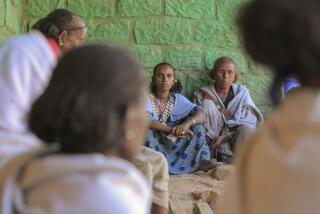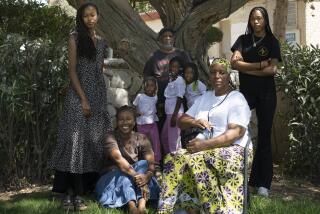An Ethiopian Exodus: Israel Airlifts Jews From Famine
- Share via
JERUSALEM — Thousands of Falashas, the black Jews of Ethiopia, have been airlifted to Israel in the last month, the biggest such exodus since the 1950s, Israeli officials said Thursday.
Details of the airlift were kept secret in order not to jeopardize Israel’s relations with third countries with whom it has no formal ties. “Human lives are at stake,” an official remarked.
Israeli officials refused to say how the Ethiopian Jews were taken out of the drought-devastated East African country. Western sources said it is likely that they were flown from neighboring Sudan, where most trekked on foot--often for weeks and at the risk of sacrificing their remaining strength.
Israel has no formal ties with either Ethiopia or Sudan.
The rescue operation was accelerated in November as Ethiopia’s drought-based famine worsened, officials said. Nearly 8 million people face starvation in Ethiopia, where tens of thousands perished in 1984, in the worst drought in African history. Two dozen other African countries are also facing death or deprivation as a result of the drought.
A majority of the Falashas are now in Israel, the Israeli officials say. At a news conference in Jerusalem, the officials put the number of Falashas in the country at about 12,000. Roughly 7,000 were known to have been here previously, so the recent airlift appears to have brought about 5,000. The total number of Ethiopian Jews is not reliably known--25,000 is one estimate, but it is no more than a good guess, and Israeli officials say no one knows for sure.
While many of the Falashas were at Israeli absorption centers for new immigrants and were learning Hebrew, others were in hospitals, most for treatment of malnutrition. Others suffered from malaria, typhoid, parasites and tuberculosis, among other diseases.
The Ethiopian famine’s toll on the arrivees was psychological as well as physical. “We have found behavior and symptoms that are reminiscent of the survivors of the concentration camps,” an Israeli doctor treating the Ethiopians told the Tel Aviv newspaper Yediot Aharonot.
The Falashas were suffering from culture shock, as well. Officials stressed the difficulties of helping the immigrants--some from rural villages--make the adjustment from dirt roads to expressways, village markets to shopping malls, barter to banking.
Reporters were allowed to meet some of those in the hospital. One of them, Tadega Getahun, 40, asked how he reached Jerusalem, told the Reuters news agency, “A man came up to me on my farm and told me . . . we would fly to Israel.”
Dressed in a green sweatsuit in the tropical diseases ward of Jerusalem’s Shaarei Tsedek Hospital, Getahun spoke through an interpreter--another Falasha, who has been in Israel for seven months.
Malaria-ridden and very thin, Getahun said that his village, in the remote northern Ethiopian region of Gondar, had no plumbing or electricity. He is now seeing such things for the first time. Asked if they frightened him, he replied that no--they made him happy.
International aid sources in Geneva--where many relief organizations have headquarters--explained that as of the end of September, the migrating Falashas had moved from Ethiopia to the Umm Rakoba refugee camp in Sudan, along with thousands of other starving Ethiopians. They added that the Falashas most likely flew to Israel from the Sudanese capital of Khartoum.
The airlift was the largest since the so-called “Magic Carpet” operations of the 1950s brought 121,000 Jews from Iraq, 47,000 Jews from Yemen and 3,000 from Aden soon after Israel became an independent state in 1948.
It also marked the largest influx of immigrants from one area since the 1970s, when thousands of Soviet Jews came in a wave that has since become a trickle.
Falashas--the word means strangers--were cut off from the rest of world Jewry for more than 1,000 years. They were rediscovered by anthropologists at the end of the 19th Century, but Israeli rabbinical authorities did not recognize them as true Jews until 10 years ago.
Israel radio said Thursday that the airlift was financed by Israel and the world Jewish community. The rescue operation was started by the government of Menachem Begin, prime minister from 1977 to 1983, it added.
Moshe Gilboa of the Israeli Foreign Ministry said the absorption of the Ethiopian Jews “refutes the cruel and incorrect assertion that Zionism equals racism.” The concept was at the heart of U.N. resolutions proposed by Arab countries.
More to Read
Sign up for Essential California
The most important California stories and recommendations in your inbox every morning.
You may occasionally receive promotional content from the Los Angeles Times.













